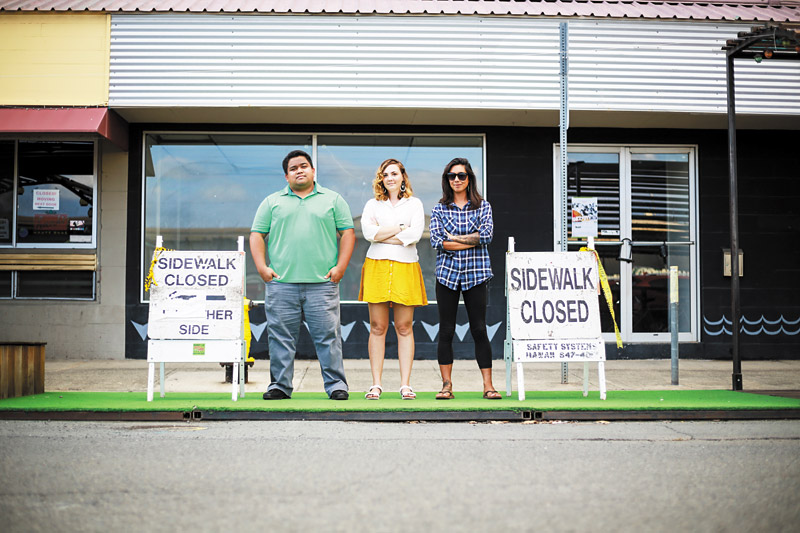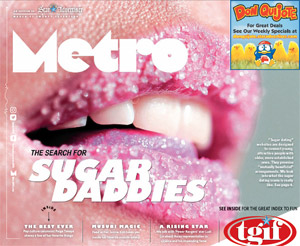PARK HERE

Representatives from some of this year’s groups participating in PARK(ing) Day are (from left) Alex Felix of HHF Planners, Adele Balderston of 88 Block Walks and Justine Espiritu of Greener Reader
In 2005, employees from San Francisco-based art and design studio Rebar paid the meter at a parking stall in the city — but instead of parking a car there, they set up an actual park, complete with some turf grass, a bench and a tree. When a photo from the event went viral, Rebar was inundated with inquiries about the project from groups that wanted to create their own parking stall-sized parks.
Since then, transforming parking stalls into parklets has grown into PARK(ing) Day, an annual, global event that takes place on the third Friday in September. It returns this Friday (Sept. 18) to cities throughout the world, including Honolulu, where various mini parks will take over streets in downtown, Chinatown and Kakaako.
The event arrived in Honolulu in 2006, and this year is poised to be the largest one yet, with a collective of several local businesses, community groups, nonprofits and state agencies slated to participate.
“It has definitely grown in momentum (locally) within the last couple of years,” says Daniel Simonich, a volunteer with nonprofit Better Block Hawaii, which aims to improve urban infrastructure and has helped to organize PARK(ing) Day. “If people can think about a public space creatively, it can add a lot of value in a way that doesn’t cost much and isn’t that difficult.
“Looking for those opportunities where we don’t have a lot of space for big parks on our island and finding ways to reuse (smaller spaces) makes sense,” he adds.

BoxJelly and fishcake partnered with Morning Glass Coffee to construct a parklet in June. Similar structures are expected on PARK(ing) Day PHOTO COURTESY NAOMI TAGA
ONE-DAY PARKING
As PARK(ing) Day lore via Rebar’s website details, the types of parklets have varied widely since that first one in San Francisco — with participants turning stalls into structures such as urban farms or public health clinics.
One local iteration this year will include an outdoor library, which also will serve as a book exchange. The goal, explains Justine Espiritu of Greener Reader, the group overseeing the parklet, is to provide a quiet, relaxing space for people to read, or just hang out.
“Reading, writing, reflecting and simply sitting outside are appreciated but not prioritized, and I think often written off as unproductive,” says Espiritu. “But I want PARK(ing) Day and our parklet to remind people how good it makes them feel.”
Environmental planning firm HHF Planners is constructing a hanging garden that will occupy a Bishop Street stall.
“We really wanted people to feel like they weren’t in the city; it really is meant to be like its own enclosed space and take you away from your immediate environment,” explains Alex Felix of HHF Planners.
“For this moment, people get to be taken away in this space,” he continues, “and hopefully they forget their troubles, even for a second.”
Other participating groups include Paiko, co-working space BoxJelly and its neighboring furniture store fishcake, nonprofits KUA, Kupu and The Trust for Public Land, and more. It’s a loosely collaborative effort where some groups are working on structures together, and they’re all sharing tips or materials. (See the sidebar for details on parklet locations.)
Providing a space to simply relax is a common theme among the participating groups, but there’s a larger, underlying goal, too. It is, in a way, a call-to-action — or at least a nod — to the importance that public spaces of this sort can have.
“You can do it almost anywhere, and I think there is sort of this untapped value in what parklets offer,” Simonich says.

Parklets can come in a various forms, with some, like this one outside of Hank’s Haute Dogs, simply providing a space to sit and relax
TINY PARKS, BIG IMPACT
A 2014 study by the European Centre for Environment and Human Health found that people who had moved to areas with more green space reported higher levels of psychological health. Similarly, according to a 2008 study by Texas State University researchers, office workers who had green space even just within view rated their job satisfaction, as well as overall life satisfaction, more positively than workers who did not.
PARK(ing) Day is meant to raise questions about the way that we utilize urban public spaces — which, with the implications of these studies in mind, become questions of not only environmental health, but also of community well-being and individual happiness. Participating groups are hoping that the event also doubles as something of rally to integrate these spaces as permanent fixtures in the urban landscape — which, with the constant construction of late, seems to entail less and less green space.
HHF’s hanging garden, for instance, serves as a commentary on depleting green space. “It’s a contrast to some of the development that we have here downtown,” says Angelica Rockquemore of HHF Planners.
“Parklets highlight how even a tiny public green space can enliven and enrich a community,” says Lea Hong, state director of The Trust for Public Land, which is sponsoring a number a PARK(ing) Day parklets. “Parklets can activate space — people can use it to read, recreate, exercise, meditate, appreciate art/performance.
“Every person … should be within a 10-minute walk of a park, natural area or public space,” Hong continues. “Nature, green space and public spaces, and art enrich our communities, connecting people to each other, to recreation and physical activity, to art and culture, and to their own communities.”
These spaces also could be a boost to business, some groups say.
“Wider sidewalks, seating and shade all promote foot traffic, which benefits local businesses,” says Adele Balderston, whose group 88 Block Walks will provide walking tours of all the Kakaako-based parklets on PARK(ing) Day.
Plus, as fishcake manager Naomi Taga points out, there’s only room for one car in a parking stall, but it could fit several people as a parklet — meaning there’s potential for a greater amount of customers.
More than anything, though, participating groups seem to be drawn to the beauty of the idea that these spaces, even when intricately planned, will be hubs of unplanned community interaction.
“Typically, on any other day, you would see just cars lined up on the side of the road,” Rockquemore says. “But to go down the same street on this one day, you can see all of these mini parks that you can go in and hang out … It can draw people together in one space and have that ephemeral moment just to make a connection and talk with someone.”
WHERE To PARK
The list below includes just some of the parklets you’ll be able to find throughout town on PARK(ing) Day, which takes place Sept. 18.
KAMANI STREET, outside of BoxJelly and fishcake in Kakaako – featuring Hawaiian music and poi pounding from 11 a.m. to 1 p.m.
COOKE STREET, outside of Kakaako Agora – featuring multiple parklets that include an outdoor library, seating and Native Hawaiian plants
AUAHI STREET, outside of Paiko in Kakaako – featuring artwork and seating
BISHOP STREET, outside of Mama-ya Bishop Street Cafe downtown – featuring a hanging garden, seating and music (and look out for a flash mob around lunchtime)
88 Block Walks will lead tours of the Kakaako-based parklets, departing from the Better Block Hawaii parklet fronting Kakaako Agora. Departure times will be about every hour, starting at noon. For more on the tours, visit 88blockwalks.com.

